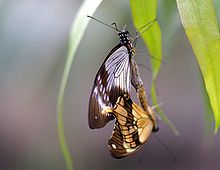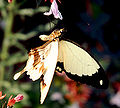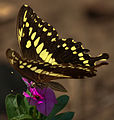- Papilio dardanus
-
Papilio dardanus 
Papilio dardanus mating Scientific classification Kingdom: Animalia Phylum: Arthropoda Class: Insecta Order: Lepidoptera Family: Papilionidae Genus: Papilio Species: P. dardanus Binomial name Papilio dardanus
Brown, 1776Subspecies see text
Papilio dardanus (the African Swallowtail, Mocker Swallowtail or Flying Handkerchief), is a species of butterfly in the family Papilionidae (the Swallowtails). The species is broadly distributed throughout sub-Saharan Africa.[1] The British entomologist E. B. Poulton described it as "the most interesting butterfly in the world".[2]
Contents
Classification
Molecular studies have provided evidence that this species' closest relative is Papilio phorcas, with Papilio constantinus being the next closest (see images below).[3]
Subspecies
Listed alphabetically.[4]
- P. d. antinorii Oberthür, 1883
- P. d. byatti Poulton, 1926
- P. d. cenea Stoll, [1790]
- P. d. dardanus Brown, 1776
- P. d. figinii Storace, 1962
- P. d. flavicornis Carpenter, 1947
- P. d. humbloti Oberthür, 1888
- P. d. meriones C. & R. Felder, 1865
- P. d. meseres Carpenter, 1948
- P. d. ochraceana Vane-Wright 1995
- P. d. polytrophus Rothschild & Jordan, 1903
- P. d. sulfurea Palisot de Beauvois, 1806
- P. d. tibullus Kirby, 1880
Mimicry
The species shows polymorphism in wing appearance, though this is limited to females, which are often given as an example of Batesian mimicry in insects. This female-limited mimicry was first described in 1869 by Roland Trimen.[5] Males have a more or less uniform appearance throughout the species' range, but females come in at least 14 varieties or morphs.[1] Some female morphs share a very similar pattern of colouration with various species of distasteful butterfly (e.g. from the family Danaidae),[6] while others have been found that mimic male appearance (andromorphs). The persistence of these various morphs or different types of females may be explained by frequency dependent selection. Cook et al. suggest that Batesian mimics gain a fitness advantage by avoiding predators, but suffer harassment from males (see sexual conflict), whereas andromorphs (male mimics) are vulnerable to predation but are not harassed by male mating attempts.[7]
Such female-limited Batesian mimicry is not unique to this species, even in the genus Papilio. For instance Papilio memnon shows a similar case of polymorphism in females.[8] Similarly, male mimicry has been observed in another insect, a damselfly (Ischnura ramburii) which also appears to have evolved camouflage to avoid sexual coercion by males.[9]
Gallery
-
Eclosion video
See also
- Dardanus (figure in Greek mythology)
- Disruptive selection
- Supergene
- E. B. Ford, Philip Sheppard and Cyril Clarke (some notable researchers)
References
- ^ a b Nijhout, H. F. (2003). "Polymorphic mimicry in Papilio dardanus: mosaic dominance, big effects, and origins". Evolution and Development 5 (6): 579–592. doi:10.1046/j.1525-142X.2003.03063.x. PMID 14984040. http://www.biology.duke.edu/nijhout/images/Dardanus2003.pdf. Retrieved 2009-08-22.
- ^ Poulton, E. B. (1924). "Papilio dardanus. The most interesting butterfly in the world". Journal of the East African and Ugandan Natural History Society 20: 4–22.
- ^ Vane-Wright, R. I.; Raheem, D. C., Cieslak, A., Vogler, A. P. (1999). "Evolution of the mimetic African swallowtail butterfly Papilio dardanus: molecular data confirm relationships with P. phorcas and P. constantinus". Biological Journal of the Linnean Society 99: 215–229.
- ^ Papilio, funet.fi
- ^ Trimen, R. (1869). "On some remarkable mimetic analogies among African butterflies". Transactions of the Linnean Society of London 26: 497–522. doi:10.1111/j.1096-3642.1869.tb00538.x.
- ^ Mallet, J. (2001). "Batesian mimicry in Papilio dardanus". http://www.ucl.ac.uk/taxome/jim/Mim2/dardanus.html. Retrieved 2009-08-23.
- ^ Cook, S. E.; Vernon, J. G.; Bateson; M., Guilford, T. (1994). "Mate choice in the polymorphic African swallowtail butterfly, Papilio dardanus: Male-like females may avoid sexual harassment". Animal Behaviour 47 (2): 389–397. doi:10.1006/anbe.1994.1053.
- ^ Mallet, James (2001). "Batesian mimicry in Papilio memnon". http://www.ucl.ac.uk/taxome/jim/Mim2/memnon.html. Retrieved 2009-09-09.
- ^ Lessells, K. (2005). "Sexual Conflict". In Encyclopedia of Life Sciences.
External links
Categories:- Papilio
- Butterflies and moths of Africa
Wikimedia Foundation. 2010.










